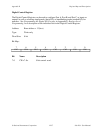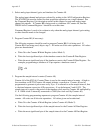Register-Level Programming Appendix E
Lab-PC+ User Manual E-2 © National Instruments Corporation
8. Write 00 (hex) to the DMATC Interrupt Clear Register.
9. Write 00 (hex) to the Timer Interrupt Clear Register.
10. Write 00 (hex) to the A/D Clear Register.
11. Read the data from the A/D FIFO Register (twice). Ignore the data.
12. Write 00 (hex) to the DAC0L, and then write 00 (hex) to the DAC0H if DAC0 is
configured for unipolar output. Write 00 (hex) to the DAC0L, and then write 08 (hex) to
the DAC0H if DAC0 is configured for bipolar output.
13. Write 00 (hex) to the DAC1L, and then write 00 (hex) to the DAC1H if DAC 1 is
configured for unipolar output. Write 00 (hex) to the DAC1L, and then write 08 (hex) to
the DAC1H if DAC1 is configured for bipolar output.
This sequence leaves the Lab-PC+ circuitry in the following state:
• Counter A0 output is high.
• Counter A1 output is high. This disables EXTCONV*.
• All interrupts are disabled.
• EXTTRIG is disabled.
• The timebase for Counter A0 is the onboard 1 MHz source.
• Analog input circuitry is initialized to RSE mode with a gain of 1 and Channel 0 selected.
• The A/D FIFO is cleared.
• The Command Registers are initialized to 00 (hex) on power up. Thus, straight binary
coding is selected for both DACs.
• The analog output circuitry is initialized to 0.0 V on both channels.
For additional details concerning the 8253 Counter/Timer, see Appendix B, OKI 82C53 Data
Sheet. For information about the 8255A PPI, see Appendix C, OKI 82C55A Data Sheet.
Programming the Analog Input Circuitry
This section describes the analog input circuitry programming sequence, how to program the
binary mode of the A/D conversion result, and how to clear the analog input circuitry. Ensure
that you have selected the appropriate analog input mode through jumper W4 and bit 3 of
Command Register 4.


















